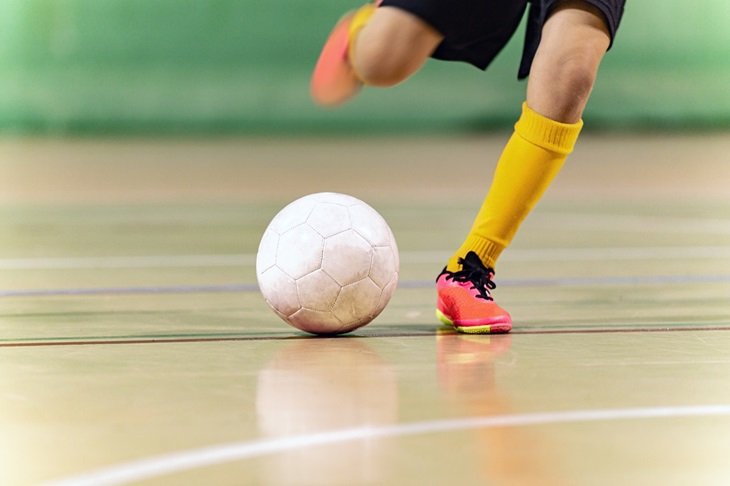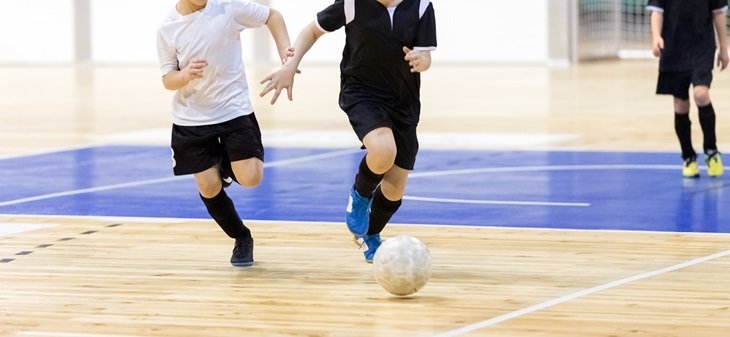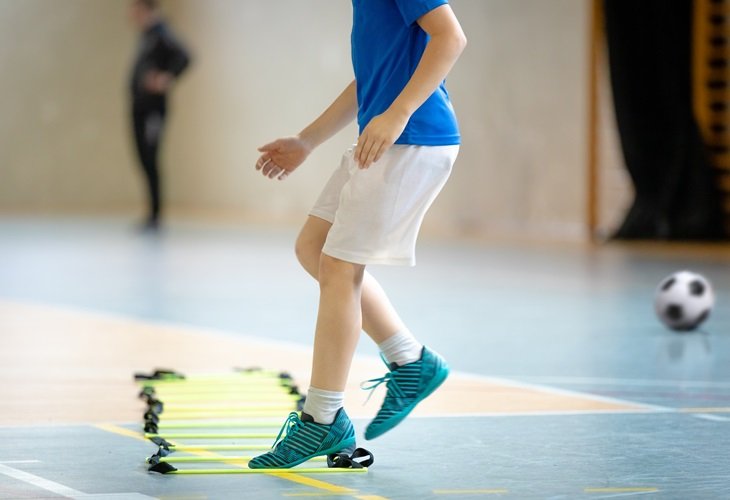
Increasingly, grassroots football teams are seeing their matches and training sessions decimated because of the inclement weather. Grass pitches will often get cut up and matches and training sessions are cancelled because of the poor conditions of the playing surface.
This is why many teams, especially at the grassroots level, try to get access to indoor facilities. In this guide, we look at some of the best indoor football drills that keep players sharp until things dry out. These training drills will help players improve their ball control, passing, and agility.
Football indoor training drills to try
- Dribbling through cones
- Small-sided games
- Rebounder passing exercises
- Agility ladder drills
- Indoor shooting practice drills
- One versus one, attack vs defence
- Rondos
Dribbling Through Cones
This drill is a simple one for coaches and managers to set up indoors, and it can really improve a player's ball control and footwork.
All you have to do is set up a row of football cones spaced a few feet apart. Then, players need to dribble the ball through the cones using both feet with the aim of keeping the ball close at all times.
This indoor football training drill can be developed by increasing the speed and using different dribbling techniques, such as asking players to use the inside, outside, and soles of their feet.
Coaches can turn this simple drill into a competition by getting different groups to try and dribble the ball through the cones as quickly as possible.
ALSO READ: The best cone drills to improve your football training sessions
Small-Sided Games

Depending on the size of the indoor space your team is training in, a great way to recreate a game situation is by planning small-sided games for your sessions. This will improve your player's decision-making, tactical awareness, and teamwork.
You can use cones or markers to mark out the pitch, and then play short, high-intensity matches. By having a small number of players, you can simulate real-game situations, but you will need one of the teams to wear football bibs so the players do not get confused.
The aim is to get your players to focus on quick passing, plenty of movement off the ball, and communicating with their teammates, which are all vital attributes on gameday.
Rebounder passing exercises
One of the best exercises you can do to improve your passing accuracy and control is using a football rebounder. Your players will need to stand a few feet away from the rebounder and pass the ball against it using both feet, and they should alternate their passes against it.
This drill should focus on one-touch passing as this can improve a player’s reflexes and speed. To make the drill more difficult, get players to move close to the rebounder to increase the passing speed or to practise passing the ball with their weaker foot.
If you have multiple rebounders, you can set two rebounders up so they are in an L-shape or a 90-degree angle and work on passing and receiving.
Agility Ladder Drills

Agility ladders are perfect football training drills for indoors and outdoors. You can perform various footwork drills such as one-foot hops, two-foot hops, lateral shuffles, and crossover steps.
You can also add a ball into an exercise by getting your players to do lateral shuffles and then passing a ball to a teammate once they have completed the agility ladder section.
Exercises involving an agility ladder help to improve a player’s foot speed and agility and are well worth including in any training session.
Fitbeast highly recommends including an agility ladder in your indoor football training sessions: “Whether you are a professional athlete or a novice athlete, agility ladder training is the perfect form of cross training because they help improve your speed, agility and agility.
“These three factors can not only improve your performance in other sports and activities but also help you improve your fitness level in almost any type of exercise, from strength training and dance to Pilates or weight exercise!”
ALSO READ: The best football warm-up and cool-down exercises
Indoor shooting practice drills
Just because you are inside and might be limited to space compared to training on a pitch, it doesn’t mean there aren’t shooting drills that you can do.
There are foldable football goals that can be used indoors, and they range in size. If you have coaching goals or small goals, you can set up two teams to keep the ball and score into the goals at each end of the pitch. For an added challenge, try one-touch finishing after a pass for this exercise.
For slightly larger indoor goals, you can practice your shooting from range with a goalkeeper in the net, or to advance this slightly, you can have a player laying the ball off to their teammate, and they have to shoot first time at the goal.
With any shooting practice, coaches often include exercises where players will shoot with both feet, focusing on placement rather than power.
ALSO READ: What is the FA guidance for grassroots football?
One versus one, attack vs defence

Another great indoor football training exercise is attack versus defence in a one versus one situation. This drill improves a player’s attacking and defending skills in small spaces that can be brought into a match.
Coaches can create a small area with a goal at one end, and then one player plays as the attacker, whilst the other is the defender, who aims to stop them from scoring.
The goal is for the attacker to dribble past the defender and score into the goal, but the defender will try to block them and win the ball from them.
The Online Soccer Academy shares some tips that defenders should follow when they are in a one versus one situation:
- Close down space and be one to two steps away from the attacker. If you are too far away, that gives them time to get their head up and look around. Get close to force their head down.
- Jockey, be patient and don't dive in. The best attackers want you to dive in on them because they will just touch it around you and go. So we want to jockey them.
- Force the attacker onto their weak foot.
- Be on your toes! Don't be back on your heels.
- Keep your feet moving; don't stand like a statue.
- Keep your eye on the ball! Do not look at the attacker's feet, hips or shoulders. Focus on the ball.
- Win the ball with confidence when the time is right. When you do step in, get your body behind you. Don't just reach and lunge for the ball with your foot.
Rondos
You’ll see that many professional teams include rondos as part of their training sessions, and this drill is one that you can easily bring indoors. One-touch rondos are great for improving decision-making, passing, and keeping possession.
To set up a rondo, you should have around five to seven players standing in a circle and one or two defenders in the middle. The players on the outside must try to keep the ball without the defenders intercepting.
You can initially allow the players on the outside of the circle as many touches as they like, but eventually, the number of touches should be reduced until they are only allowed one touch.
ALSO READ: Who can play grassroots football?
Football indoor training tips
Although indoor spaces often mean smaller areas, this guide shows you plenty of exercises and drills you can still plan for your training sessions, which work on ball control, fitness, passing, movement, and shooting.
If your football training sessions are indoors and you are looking for football products, Diamond Football offers a wide range of equipment. We are the experts in football training equipment and supply everything from football rebound nets to football training poles.
For more tips, guides, and advice, visit our news page.




